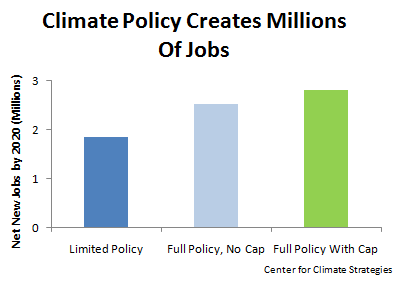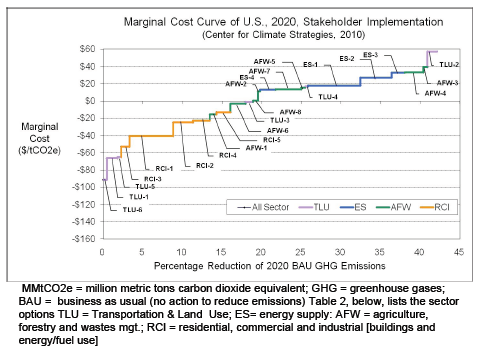Cross-posted from Wonk Room.
A new macroeconomic analysis of green economic policies finds that cutting global warming pollution will make the economy grow faster. The Center for Climate Strategies (CCS), building upon analysis they did of state-level climate plans for the National Governors Association, analyzed the economic and environmental impact of legislation in line with the planned Kerry-Graham-Lieberman framework. As long as state-level policies are boosted instead of pre-empted, CCS found that previous economic analyses by federal agencies and industry groups are wrong. This CCS analysis finds that instead of slowing the economy, household wealth and jobs will grow faster in a green economy. Carbon limits and efficiency-focused policies would have a net positive employment impact of 2.8 million jobs and expand the economy by $154.7 billion by 2020, while U.S. emissions are cut to 27 percent below 1990 levels — if strong standards are set:

The modeled job creation is consistent with the findings of Political Economy Research Institute at the University of Massachusetts, which used an input-output model to find that a green economy would create 1.7 million new jobs. The center looked at three different policy scenarios, using the industry-standard REMI Policy Insight PI+ macroeconomic model:
– Strong local, state and federal implementation of green economic policies like green building codes and smart growth
– These strong policies combined with a federal cap-and-trade system and coupled fuel fee to guarantee emissions reductions of 27 percent below 1990 levels by 2010
– Scaled-back implementation of the policies and cap-and-trade system in line with President Obama’s goal of six percent below 1990 levels, similar to the Kerry-Graham-Lieberman bill soon to be considered
The cap-and-trade system modeled uses full auction of permits and 75 percent of proceeds going directly back to consumers and 25 percent going to technology investments. No proceeds are dedicated to deficit reduction, as none is needed — a faster-growing economy will increase other tax receipts.
In every single scenario, policies that cut waste and save money by eliminating market failures predominate, making the U.S. economy a more efficient free market and accelerating job growth and household wealth. The report finds that stronger environmental targets and standards deliver greater economic benefits — even if the tremendous benefits of reducing pollution have for health and environmental costs are ignored.
The 23 recommended climate strategies range the gamut from agriculture, energy supply, electricity use, to transportation. These strategies — most of which save money — combined can achieve major carbon pollution reductions:

This is what true all-of-the-above energy policy looks like. The suite of recommended policies coming from the consultants to the Center for Climate Strategies report — the stakeholders in local and state governments, businesses, and energy users — must be taken as a top priority, even if they don’t have an army of lobbyists to promote this green economic agenda. The current level of ambition in Washington is not only insufficient to mitigate the damages of global warming, it is leaving hundreds of thousands of jobs on the table.


